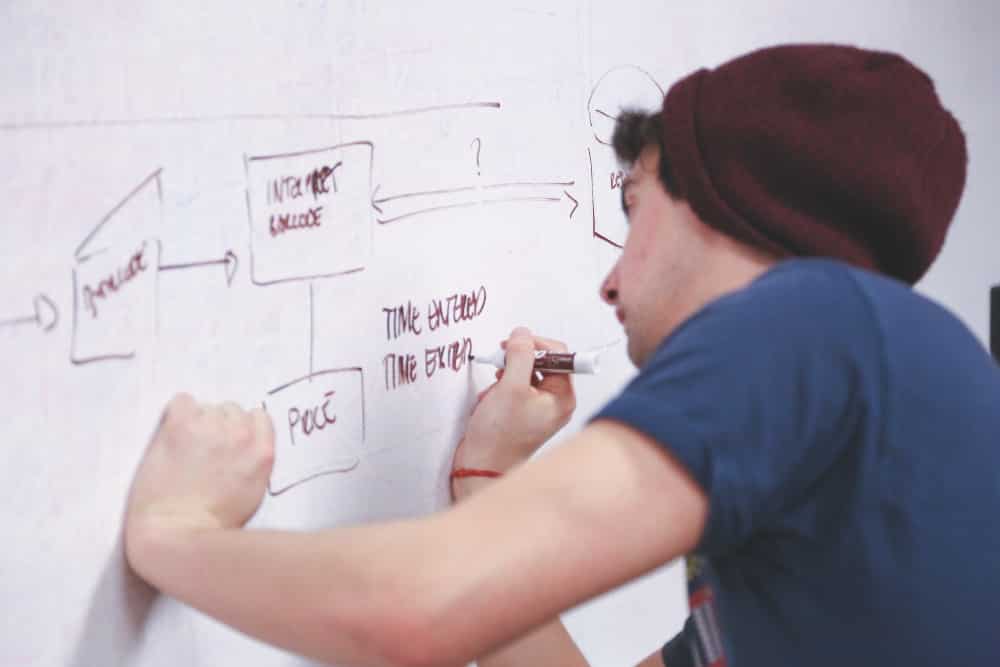This article has been contributed by Roli Edema.
One of the most widely acknowledged principles in business is the importance of understanding your customer and designing for them.
A deep understanding of your target customer often translates into perceptive design decisions that help you build strong brand awareness.
In recent years, the concept of human-centered design has emerged as an approach to involving the human perspective in all stages of the problem-solving process.
There are various creative approaches that companies of all sizes can use to gain insights into customer pain points and core needs. Let’s look at ways that entrepreneurs and small business owners can place a greater emphasis on human-centered design to create better products.
Why Put People at the Center of the Design Process?
A failure to connect with the target audience and create real value is one of the foremost reasons why new businesses fail. Keeping people at the center of the design process helps you avoid making false assumptions that could potentially be disastrous to your business.
It’s easy to get into the trap of thinking of creating what you think is a great product. After all, it’s exciting when you think you’ve found a great solution. But without research to back it up, you may not be addressing the problem that your customer actually wants to solve. Human-centered design helps you navigate the early stages of product creation by focusing on the problem rather than the solution.
In business, it’s quite ideal if you are in your target audience. But what if you aren’t? How can you design an excellent product or service if you don’t have experience in that area? That’s another reason to involve users in the design process. Keeping people at the center of the design process enables you to create products that provide optimum user experiences and effortless interaction. It also enables you to innovate with more success and less risk, improving your overall design strategy.
Common Methods of Approaching Human-Centered Design

Three common ways of involving humans in the design process are through surveys and questionnaires, focus groups, and by using prototypes.
- Surveys and Questionnaires help you gather customer perspectives through a series of targeted questions. They’re useful because they allow you to quickly collect answers from a large number of people. Product surveys can help you narrow down your target audience and gauge interest in a new product or service.
- Focus Groups are another popular tool for measuring customer reactions. Focus groups can help determine user viewpoints on elements such as a product’s design, packaging, message or price. Non-verbal responses, i.e. facial expressions and body language can supply further insights and provide information that’s easier to understand than statistical data.
- Prototypes are an effective way to make ideas more tangible. Prototypes enable you to test and explore ideas before too many resources get used. The goal of prototyping is to create something that’s quick, inexpensive and easy for users to connect with. Prototypes allow human-centered designers to learn through making, and then quickly get feedback from the people they’re designing for. Trying out multiple prototypes and testing them with users can help uncover challenges and subtleties in design.
More Creative Ways to Approach Human-Centered Design in Business
The above methods are useful ways to involve users in the design process, but they’re not the only options. There are other, more creative ways for business owners to approach human-centered design and collect fascinating insights about consumer perceptions.
Ideo is a global design company that’s famous for its creative approach to human-centered design. They created Method Cards as a tool to help designers understand people, their experiences, behaviours, perceptions and needs. The cards are divided into four categories representing ways to empathize with people:
- Learn
- Try
- Ask
- Look
Let’s identify practical ways to apply some human-centered methods in these four categories to your business and product design process.
1. Learn from Your Data
Designing for humans involves gathering requirements and learning from your data. Here are some activities that can help you identify patterns and insights:
a. Character Profiles
Character profiles or buyer personas are a useful way to bring a typical customer to life. Based on observations of real people, you can develop profiles to represent archetypes and the details of your target customer’s behaviour or lifestyle. Personas help you understand your customers better, making it easier for you to tailor your content, messaging and product development to meet the specific needs of members of your target audience.
b. Flow Analysis
Flow analysis is a useful way to identify bottlenecks in product or system design. It involves representing the flow of information or activity through all phases of a system or process. It’s extremely useful when you are trying to build a tool for businesses where information flows between multiple people or programs, i.e. a registration or membership system.

Flow analysis can be used for a variety of projects. It can help you design a seamless experience for users navigating a website, and it can also help with the design of physical products. For example, if you are in the card design business, a flow analysis can help you better understand the journey of a card (where it travels around the house) once it’s received.
c. Long-Range Forecasts
Understanding trends is essential for human-centered design. The idea with long-range forecasts is to write up scenarios that describe how social or technological trends might influence people’s behavior and the use of a product, service or environment. This activity can help you get a better understanding of the long-range implications of design decisions.
2. Try Being the Customer
Putting yourself in your customer’s shoes and reflecting on the experience is a good way to understand what type of product your customer needs. Here are a few creative ways to empathize with your customer:
a. Role-Playing
It’s good practice to constantly be looking for ways to challenge yourself and step out of your comfort zone as a business owner, both personally and professionally. Role-playing is a great way to do this, and it’s an activity that can help you better connect with your customer. Role-playing involves identifying the stakeholders involved in the design problem and assigning those roles to members of your team.
Role-playing can help you answer the following questions about your typical customer and the activity that a product would be used for:
- What problems exist during the activity?
- How do they do their work/activities?
- What is the social situation around the activity?
- What cognitive or emotional constraints do they deal with?
- What inspires or motivates them in their activities?
By enacting activities within a real or imagined context, the team can trigger empathy for actual users and raise other relevant issues.
b. Predict Next Year’s Headlines

This activity challenges you to project your company into the future, identifying how you want to develop and sustain customer relationships. Your predictions can help you define which design issues to pursue in product development. Defining and clarifying upcoming targets also helps ensure that your design methods align with your overall business goals.
c. Scenarios
Scenarios can highlight the ways in which particular design ideas serve different user needs. For example, you could create a storyboard that describes the context of use for a product or service. This can help to communicate the essence of a design idea within the context that it will likely be used, and it is especially useful for the evaluation of service concepts.
Scenario testing is a related activity where you show users a series of cards depicting possible future scenarios and invite them to share their reactions. This is a useful way to evaluate early design concepts.
3. Ask for Feedback
Opportunities to get direct feedback from your ideal customer are priceless. Here are ways to enlist people’s participation and elicit information that’s relevant to your project.
a. Narration
Narration can be a useful way to assess people’s motivations, concerns, perceptions and reasoning. Invite your customer to perform a specific task and ask them to describe aloud what they are thinking. This gives you insight into the way a customer’s mind works as they complete a routine activity or use a product. It’s a great way to pick up subtleties in people’s thought patterns that you may never have known of otherwise!
b. Unfocus Group
You’ve heard of focus groups, but are you familiar with unfocus groups? Focus groups are a traditional method where the conversation is centered around a particular topic. However, unfocus groups are more flexible and encourage members of the group to contribute to the conversation without an agenda, discussion guide or main topic. These kinds of discussions are user-centric and allow you to stumble on valuable insights because you aren’t confined by structure or biases.

How do you implement an unfocus group in your business?
Assemble a diverse group of individuals in a workshop to use a stimulating range of materials and create things that are relevant to your project. The interactions in an unfocus group are rich and creative, and open up new ways of thinking about design.
c. Draw the Experience
This fun activity can help you identify what consumers think a product should look like, even before you start creating anything. Ask participants to visualize an experience by drawing it and using diagrams. This can be a good way to debunk assumptions and reveal how people truly envision a process.
For example, if you are designing an eCommerce website, getting people to draw their experience can help you picture the order in which people complete certain actions, and where on the screen they expect certain buttons to be.
4. Look at What People Really Do
Good observation skills can help you design products and services that people truly love. Observing people allows you to discover what people actually do rather than what they say they do. Here are methods that can help you watch and learn from potential customers:
a. Fly on the Wall
The fly on the wall technique is where you gather participants to observe and record their behavior within its context, without interference. This is useful in product design because it enables you to see what people do within real-life contexts and time frames, rather than accept what they say they did after the fact. People are often forgetful, so this method helps you pick up on details they might have missed.
Shadowing is a related activity where you tag along with people to observe and understand their day-to-day routines, interactions and contexts. Shadowing can reveal design opportunities and how a product might affect or complement users’ behaviour.
b. Personal Inventory
Observing the way people talk about things that are important to them can help you understand how a product or service fulfills a particular need. Ask your participants to document and describe personal objects they handle and encounter every day. This activity is a method of cataloguing evidence of people’s lifestyles, preferences and values. It can also help you identify patterns in behaviours and perceptions.
c. Social Network Mapping
Identify the different kinds of social relationships within a customer group and map the network of their interactions. People are influenced by other people, and this method helps in figuring out which individuals hold what levels of influence over other individuals or groups.
Social network mapping can also provide you with insights into interpersonal and professional network structures. Understanding the social networks of your target customers can help you discover new ways to reach them. It can also inform you on the types of messaging that resonate best within their social circles, enabling you to craft stronger emotional appeals in your marketing.
Conclusion
Keeping humans at the center of the design process will consistently result in the delivery of better products and services.
As a business owner, the concept of human-centered design does not have to be intimidating or overly technical. It just requires being proactive and taking advantage of opportunities to get customers involved in the conversation.
As you make it a priority to get feedback from current and potential customers, you’ll continue to equip yourself with insights needed to build a well-respected brand. When you learn, look, ask and try, you’ll let your customers tell you exactly what they want, and you’ll discover how best to provide it to them.
_
About the author: Roli Edema is a personal development author and digital marketer. She runs the blog roliedema.com where she shares useful insights to help individuals reach their personal, career and business goals.
No comments:
Post a Comment